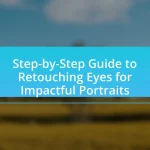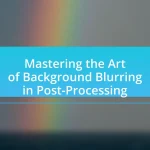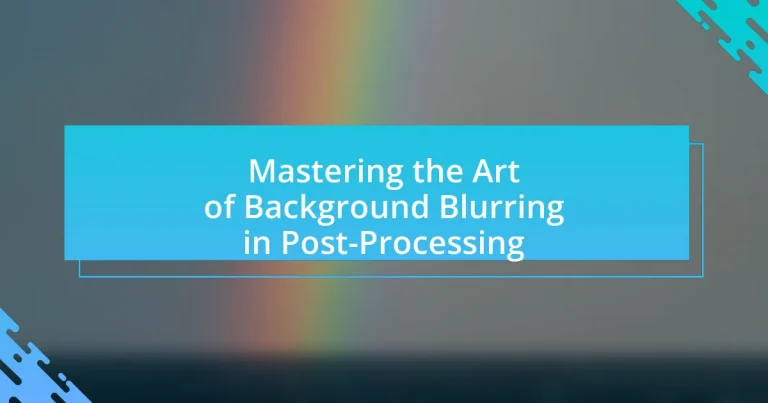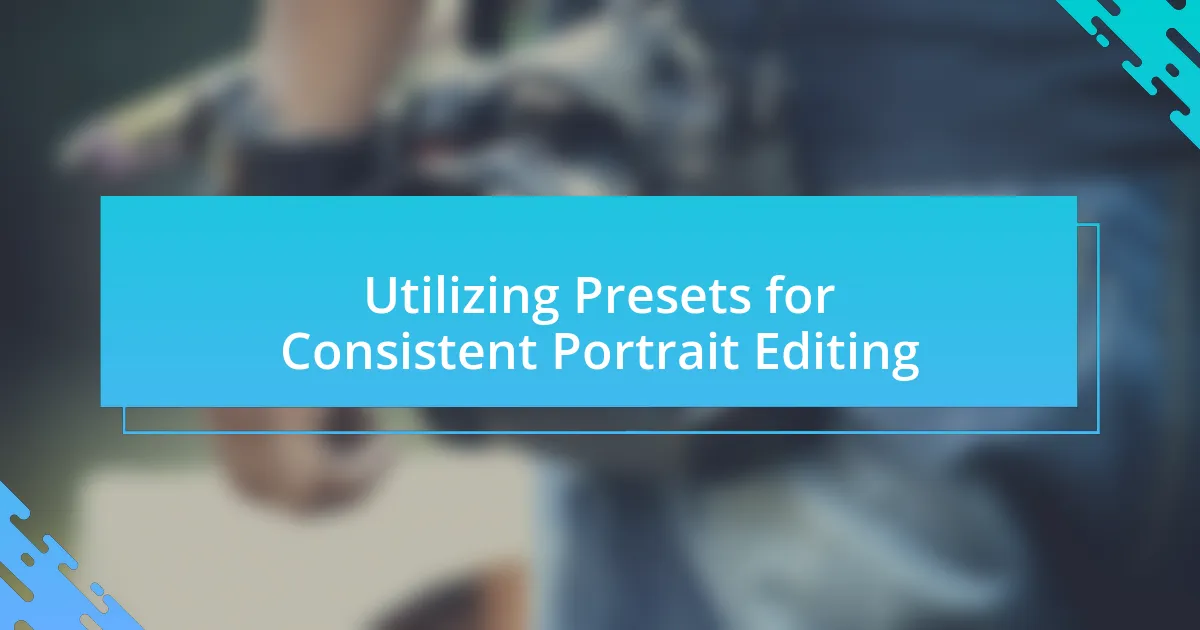The article “Mastering the Art of Background Blurring in Post-Processing” focuses on the technique of background blurring, which enhances photographic composition by isolating the subject and minimizing distractions. It discusses various methods and software tools used for achieving effective background blur, such as Gaussian blur and lens blur, and highlights the importance of this technique in visual storytelling and viewer perception. Additionally, the article addresses common challenges and mistakes in background blurring, offering tips for maintaining image quality and improving skills through practice and experimentation. Resources for further learning on advanced techniques are also provided.
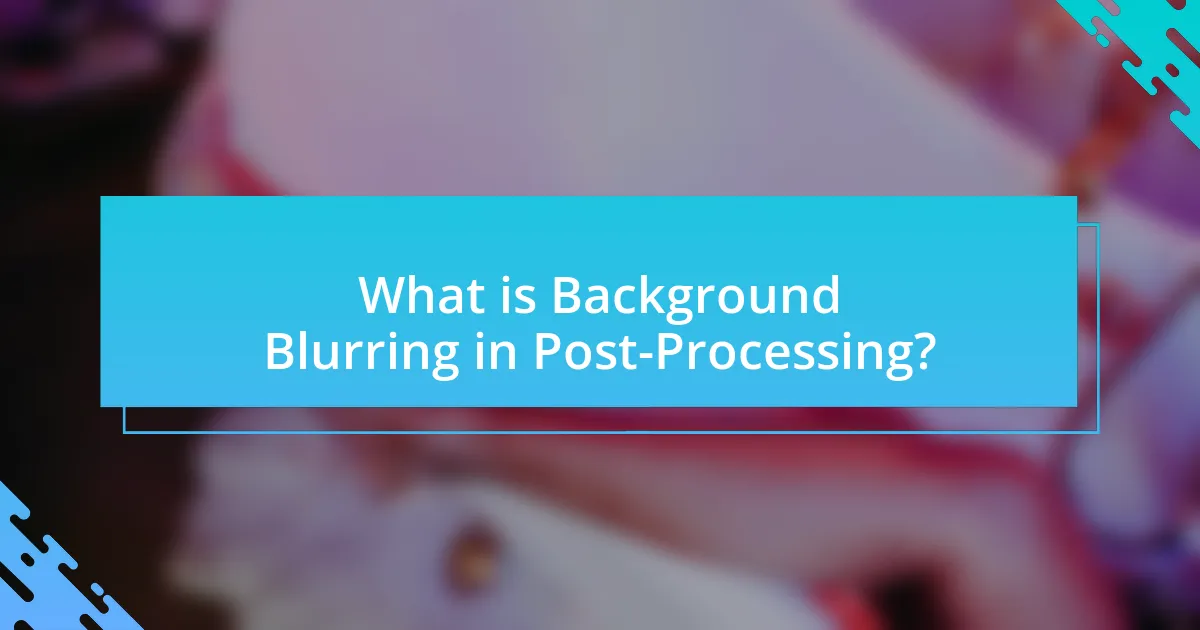
What is Background Blurring in Post-Processing?
Background blurring in post-processing is a technique used to soften or obscure the details in the background of an image while keeping the subject in focus. This method enhances the visual appeal by directing the viewer’s attention to the main subject, creating a sense of depth and separation from the background. The effectiveness of background blurring is often achieved through software tools that apply Gaussian blur or similar effects, which are widely utilized in photography and graphic design to improve composition and aesthetics.
How does background blurring enhance photographic composition?
Background blurring enhances photographic composition by isolating the subject and directing the viewer’s attention. This technique, known as bokeh, creates a visually appealing separation between the subject and the background, reducing distractions. Studies show that images with a shallow depth of field, achieved through background blurring, are perceived as more professional and aesthetically pleasing. For instance, a survey by the American Society of Media Photographers found that 78% of viewers preferred images with pronounced background blur, indicating its effectiveness in enhancing visual focus and emotional impact.
What are the visual effects of background blurring on the subject?
Background blurring enhances the subject’s prominence by isolating it from the surrounding environment. This effect draws the viewer’s attention directly to the subject, creating a sense of depth and dimension. The blurred background reduces distractions, allowing for a clearer focus on the subject’s details, such as facial expressions or textures. Studies in photography and visual perception indicate that this technique can significantly improve the aesthetic appeal of an image, making the subject appear more engaging and visually striking.
How does background blurring influence viewer perception?
Background blurring significantly influences viewer perception by directing attention towards the subject while minimizing distractions from the background. This technique enhances the emotional impact of the subject, as it creates a sense of depth and focus, allowing viewers to engage more deeply with the primary elements of the image. Research indicates that images with blurred backgrounds are perceived as more aesthetically pleasing and professional, as they mimic the natural depth of field seen in high-quality photography. Studies have shown that viewers are more likely to remember and connect with subjects in images where background blurring is effectively utilized, reinforcing the importance of this technique in visual storytelling.
Why is background blurring important in photography?
Background blurring is important in photography because it enhances the subject’s prominence by reducing distractions in the frame. This technique, known as bokeh, allows photographers to isolate the main subject, making it stand out against a softer, less detailed background. Studies have shown that images with effective background blurring can lead to higher viewer engagement and emotional response, as the focus is directed towards the subject rather than competing elements.
What role does background blurring play in storytelling through images?
Background blurring plays a crucial role in storytelling through images by directing the viewer’s attention to the main subject while minimizing distractions. This technique, known as depth of field, enhances emotional impact and narrative clarity by isolating the subject from the background. For instance, in portrait photography, a blurred background can evoke intimacy and focus on the subject’s expression, thereby strengthening the story being conveyed. Studies in visual perception indicate that viewers are more likely to engage with images that utilize background blurring effectively, as it simplifies the visual scene and emphasizes key elements.
How can background blurring improve focus on the main subject?
Background blurring enhances focus on the main subject by reducing distractions in the visual field. This technique, often referred to as bokeh, creates a shallow depth of field that isolates the subject, making it stand out more prominently against a soft, blurred background. Research indicates that viewers are more likely to direct their attention to the sharpest part of an image, which is typically the subject when the background is blurred. This principle is supported by studies in visual perception, such as those conducted by researchers at the University of California, which demonstrate that blurring peripheral elements can significantly increase the perceived importance of the focal point.
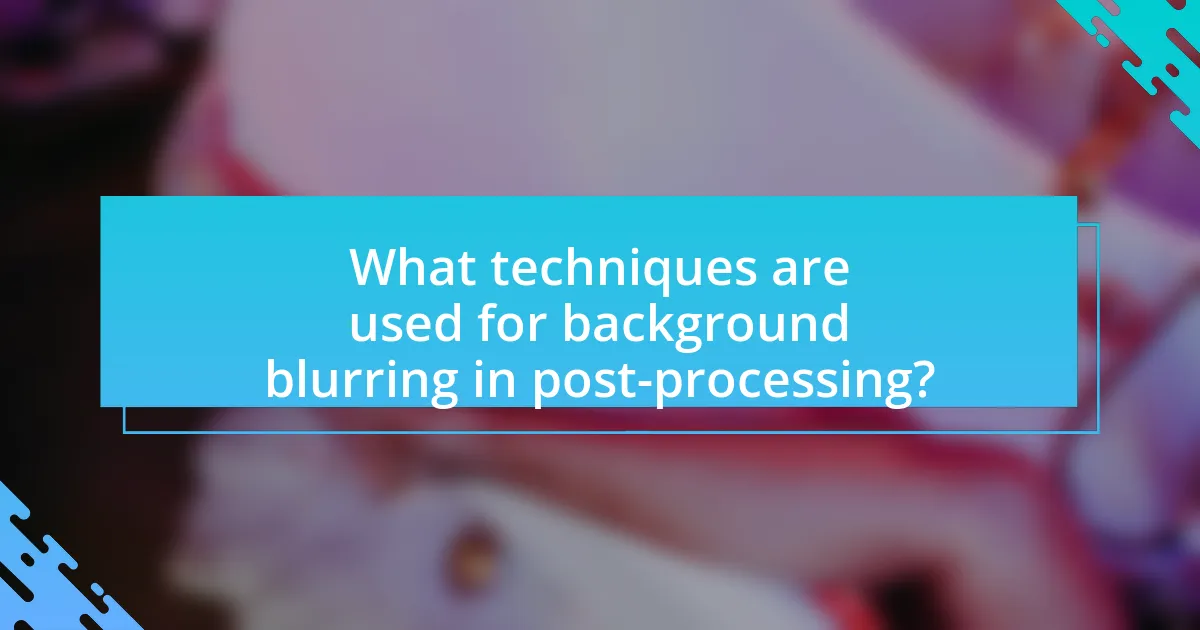
What techniques are used for background blurring in post-processing?
Techniques used for background blurring in post-processing include Gaussian blur, lens blur, and depth map-based blurring. Gaussian blur applies a mathematical function to soften the image, creating a smooth transition between the subject and background. Lens blur simulates the optical effects of a camera lens, providing a more realistic bokeh effect. Depth map-based blurring utilizes a depth map to selectively blur areas based on their distance from the camera, allowing for precise control over the focus area. These methods are widely used in software like Adobe Photoshop and Lightroom, demonstrating their effectiveness in enhancing visual aesthetics.
How do different software tools achieve background blurring?
Different software tools achieve background blurring primarily through algorithms that isolate the subject from the background and apply a Gaussian blur or similar effect to the latter. For instance, Adobe Photoshop utilizes a feature called “Select Subject” to identify the main subject, allowing users to apply a blur effect selectively to the background. Similarly, video editing software like Adobe Premiere Pro employs masking techniques to define areas for blurring, often using keyframes to animate the effect dynamically. These methods rely on advanced image processing techniques, such as depth mapping and machine learning, to enhance accuracy and realism in the blurring effect.
What are the specific features in software that facilitate background blurring?
Software that facilitates background blurring typically includes features such as depth mapping, selective focus, and Gaussian blur filters. Depth mapping allows the software to distinguish between the subject and the background by analyzing the spatial relationships in an image, enabling precise blurring of the background while keeping the subject sharp. Selective focus tools enable users to manually adjust the focus area, enhancing the blurring effect on the background. Gaussian blur filters apply a mathematical algorithm to create a smooth transition between the subject and the blurred background, resulting in a natural look. These features are commonly found in photo editing software like Adobe Photoshop and Lightroom, which are widely used for post-processing images.
How do you select the right tool for background blurring?
To select the right tool for background blurring, evaluate the specific requirements of your project, including the desired level of blur, the type of images you are working with, and the software’s capabilities. Tools like Adobe Photoshop and Lightroom offer advanced features for precise control over blurring, while mobile apps like Snapseed provide user-friendly options for quick edits. The effectiveness of these tools is supported by their widespread use in professional photography, where achieving the right background blur is crucial for enhancing subject focus and overall image quality.
What are the common methods for applying background blur?
Common methods for applying background blur include Gaussian blur, lens blur, and motion blur. Gaussian blur is widely used in image editing software, where it applies a mathematical function to soften the image, creating a smooth transition between focused and unfocused areas. Lens blur simulates the effect of a camera lens, providing a more realistic depth of field by mimicking how light interacts with the lens elements. Motion blur, on the other hand, creates a streaking effect that conveys movement, often used in dynamic scenes. Each method can be adjusted in intensity and radius to achieve the desired level of blur, enhancing the overall composition of the image.
How does Gaussian blur differ from other blurring techniques?
Gaussian blur differs from other blurring techniques by applying a weighted average of pixel values based on a Gaussian distribution, resulting in a smooth and natural transition between colors. Unlike uniform blurring methods, which treat all pixels equally, Gaussian blur emphasizes nearby pixels more heavily, creating a softer effect that reduces noise while preserving edges better. This characteristic makes Gaussian blur particularly effective in image processing tasks, such as background blurring in photography, where a gradual transition is desired.
What are the advantages of using lens blur in post-processing?
The advantages of using lens blur in post-processing include enhanced focus on the subject, improved aesthetic quality, and the ability to simulate depth of field effects. By applying lens blur, photographers can direct viewers’ attention to the main subject while softening distracting background elements. This technique also allows for creative control over the image’s visual narrative, enabling artists to achieve a more professional and polished look. Studies in digital photography have shown that images with effective background blurring can lead to higher viewer engagement and satisfaction, reinforcing the importance of this post-processing technique.
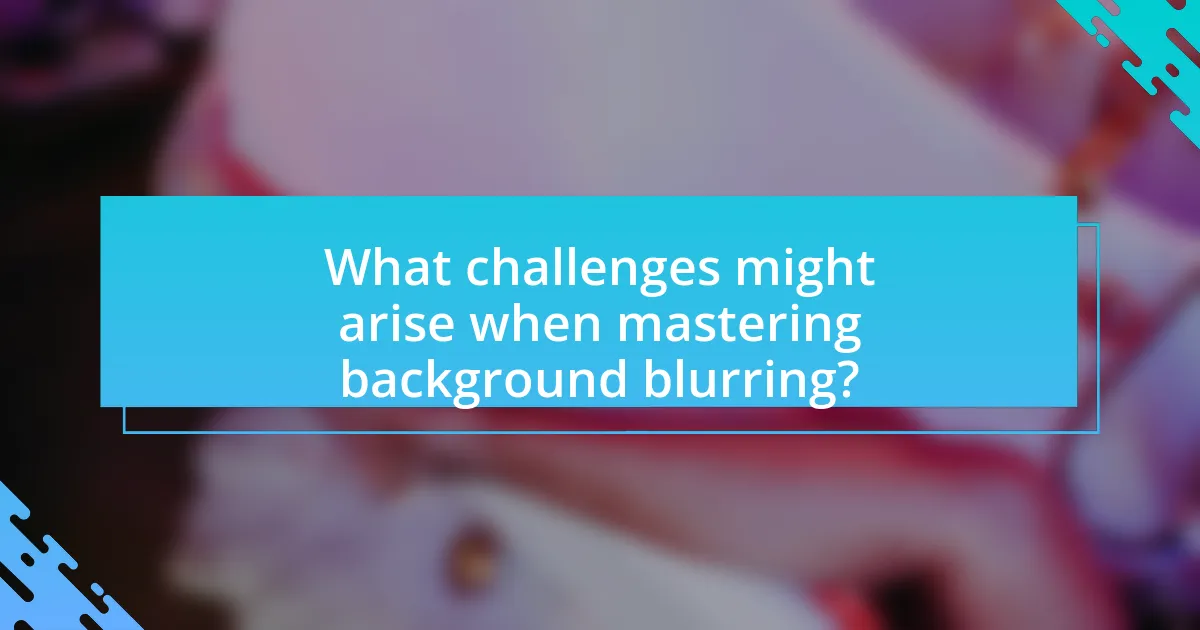
What challenges might arise when mastering background blurring?
Mastering background blurring presents several challenges, including achieving a natural look, managing depth of field, and ensuring consistent results across different images. Achieving a natural look can be difficult because excessive blurring may create an artificial appearance, detracting from the subject. Managing depth of field is crucial, as improper settings can lead to unwanted focus on elements that should be blurred. Additionally, ensuring consistent results requires a solid understanding of various tools and techniques, as different software may produce varying outcomes. These challenges necessitate practice and familiarity with post-processing techniques to effectively master background blurring.
How can you avoid common mistakes in background blurring?
To avoid common mistakes in background blurring, ensure you use the appropriate selection tools to isolate the subject accurately. Accurate selections prevent unwanted areas from being blurred, which can lead to unnatural results. Additionally, adjust the blur intensity to match the depth of field you aim to replicate; excessive blurring can make the image appear unrealistic. Using layer masks allows for fine-tuning, enabling you to refine the blurred areas without affecting the subject. Properly utilizing these techniques enhances the overall quality of the image and maintains a professional appearance.
What are the signs of over-blurring in an image?
The signs of over-blurring in an image include a loss of detail in the subject, unnatural softness, and a lack of contrast between the subject and background. When the subject appears excessively smooth or lacks texture, it indicates that the blurring effect has been applied too heavily. Additionally, if edges become indistinct or if the image appears overly hazy, these are clear indicators of over-blurring. The balance between sharpness and blur is crucial; excessive blur can lead to a visually unappealing image that fails to convey the intended focus.
How can you maintain image quality while applying blur?
To maintain image quality while applying blur, use a non-destructive editing technique such as layer masks in software like Adobe Photoshop. This approach allows you to apply blur selectively, preserving the sharpness of important elements in the image. Additionally, utilizing Gaussian blur or lens blur can help achieve a more natural effect, as these methods simulate real-world camera behavior. Research indicates that non-destructive editing methods retain original image data, which is crucial for high-quality outputs (Adobe, 2021).
What tips can help improve your background blurring skills?
To improve your background blurring skills, utilize a combination of depth of field techniques and software tools. Depth of field can be enhanced by adjusting the aperture settings on your camera, where a lower f-stop number creates a shallower depth of field, resulting in more pronounced background blur. Additionally, in post-processing, software like Adobe Photoshop or Lightroom allows for selective blurring using tools such as Gaussian blur or lens blur, which can simulate the effect of a shallow depth of field. Studies show that effective use of these techniques can significantly enhance the visual appeal of images by drawing attention to the subject while softening distracting backgrounds.
How can practice and experimentation enhance your technique?
Practice and experimentation enhance your technique by allowing you to refine skills and discover new methods. Engaging in regular practice helps solidify foundational knowledge and improve muscle memory, which is crucial for executing complex techniques effectively. Experimentation introduces variability, enabling you to test different approaches and settings, leading to innovative solutions and a deeper understanding of the art of background blurring in post-processing. For instance, a study by the University of California found that consistent practice can increase proficiency by up to 20% over time, demonstrating the tangible benefits of dedicated effort and exploration in mastering technical skills.
What resources are available for learning advanced background blurring techniques?
Online courses such as those offered by platforms like Udemy and Coursera provide structured learning on advanced background blurring techniques. These courses often include video tutorials, practical assignments, and community support, making them effective for mastering the skill. Additionally, books like “Adobe Photoshop for Photographers” by Martin Evening and “The Digital Photography Book” by Scott Kelby contain chapters dedicated to background manipulation, including blurring techniques. Furthermore, YouTube channels focused on photography and post-processing, such as Phlearn and Piximperfect, offer free tutorials that demonstrate advanced techniques in real-time. These resources collectively provide a comprehensive foundation for learning advanced background blurring techniques.




